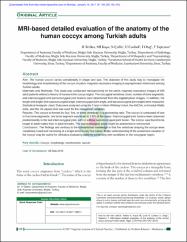MRI-based detailed evaluation of the anatomy of the human coccyx among Turkish adults
Abstract
Aim: The human coccyx varies considerably in shape and size. The objective of this study was to investigate the morphology and morphometry of the coccyx on pelvic magnetic resonance imaging in asymptomatic individuals among Turkish adults. Materials and Methods: This study was conducted retrospectively on the pelvic magnetic resonance images of 456 adult patients without a history of trauma in the coccyx region. The coccygeal vertebrae count, number of bone segments, and intercoccygeal and sacrococcygeal joint fusions were determined from the sagittal plane images. In addition, the length and angles (the sacrococcygeal angle, intercoccygeal joint angle, and sacrococcygeal joint angle) were measured. Statistical Analysis Used: Data were analyzed using the T-test or Mann-Whitney U-test, the ANOVA, or Kruskal-Wallis tests, and the chi-square test was used for the categorical variables. Results: The coccyx is formed by four, five, or three vertebrae in a decreasing ratio. The coccyx is composed of one to five bone segments; one bone segment was found in 2.8% of the cases. Intercoccygeal joint fusions been observed predominantly in the last intercoccygeal joint, with or without sacrococcygeal joint fusion. The coccyx was found to be longer in adult males than in adult females. The sacrococcygeal angle might be anteverted or retroverted. Conclusion: The findings are contrary to the conventional knowledge in that the vertebrae shaping the coccyx were completely fused and consisting of a single bone in very few cases. Better understanding of the anatomical variation of the coccyx may be useful for clinicians evaluating patients presenting with conditions in the coccygeal region.


















